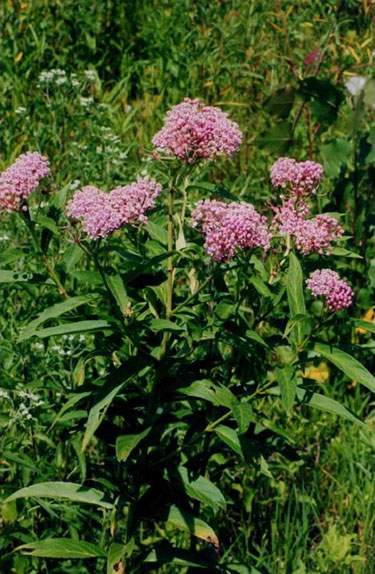Swamp Milkweed in the Landscape

Stephen Love, University of Idaho
Scientfic Name: Asclepias incarnataCommon Name: Swamp Milkweed, Pleurisy Root, Rose Milkweed, White Indian Hemp
Description: Swamp milkweed has less aesthetic importance than many of the native plants used in water-conserving landscapes. However, it is a valuable pollinator species for numerous native insects, including the threatened monarch butterfly. This species is also surprisingly drought tolerant given the damp nature of its common habitat. Mature plants of swamp milkweed are relatively tall (30 to 40 inches) and can be leggy. Capitate heads of light to dark pink flowers appear in July and August. Flowers are followed by curved fleshy pods filled with white fluff and flat, dark seeds. Swamp milkweed can but used in the garden for pollinator habitat development. It is suitable for planting where growing conditions are difficult. The species provides the unique benefit of being resistant to predation by deer. (Photograph by Jennifer Anderson - hosted by the USDA-NRCS Plants Database.)
Native Habitat: Asclepias incarnata has an extensive natural range that includes the eastern three-fourths of the US and is native in a significant portion of the Intermountain West. Natural habitat includes damp sites such as wet meadows, flood plains, riverbanks, pond shores, marshes, and wet woods. It also can be found growing in dry prairies, fields, and roadsides. Habitat elevation ranges widely.
Cultural Requirement
Soil: Prefers moist, clay soils but will withstand a range of conditions if given adequate moisture, including sandy and alkaline soils. Optimum appearance will require moderate soil fertility.
Moisture Tolerance: Prefers consistently moist conditions but will withstand periods of drought. Best appearance is accompanied by supplemental irrigation during extended dry periods.
Sun/Shade/Preference: Tolerant of full sun or part shade.
Transplanting: Swamp milkweed will tolerate pot-to-pot transplanting if seedlings are relatively small and the long taproot is protected during the procedure. Potted plants handle transplanting into the garden without issue.
Propagation: Best grown from seeds. Seeds of swamp milkweed require at least three weeks of cold stratification to produce uniform germination. Seed can be planted into flats and allowed to germinate, after which seedlings are teased out and transplanted into deep pots. Young seedlings grow rapidly and often get leggy and tall in the pots. Swamp milkweed plants are best grown in deep 4-inch pots or larger containers for sale in spring. Plants are often less attractive after extended periods in pots.
Maintenance (pruning, fertilization, deadheading, division, irrigation, etc): Swamp milkweed is an easy-care species. In late fall, senescing stems should be removed to maintain attractiveness for the subsequent season. Supplemental irrigation is required in most Intermountain regions to encourage healthy growth and full bloom potential. Routine light fertilization is recommended, especially if plants show poor vigor.
Insect, disease, or other problems: Pests and diseases are uncommon with swamp milkweed. The tender, young sprouts occasionally become infested with aphids. Aphids can be washed off the plants with a high-pressure stream of water. Light infestations are usually resolved naturally by the presence of predators and parasitoids.
Landscape Value
Use in the Landscape: Swamp milkweed is a seasonally attractive tall feature that can be used to create pollinator habitat in beds and borders. To compensate for tall, lanky form, it should be grouped or planted singly behind shorter plants in the back of a plot.
Weediness/Invasive Potential: Although occasional seedlings will show up in the garden, swamp milkweed is not considered weedy from seed and unlike many of the species in this genus, spreads only slowly from rhizomes.
Foliage: Stems of swamp milkweed grow from an underground crown. Stems are long, unbranched, and stiffly upright or slightly spreading. Leaves are large, elongated, and leathery with smooth edges. Leaves are covered with sparse, flattened hairs. Foliage exudes milky sap when damaged.
Flower: Flowers develop in large, capitate heads and are light to medium pink or pinkish purple in color. Petals of individual flowers are fleshy and open widely and angle backward along the stem.
Timing: June-July.
Fruit: A small percentage of flowers produce large, fleshy, somewhat curved, sharply pointed capsules. When dry, the capsules split to release masses of fluff in which the large, flat, black seeds are embedded.
Form: Stiffly upright to slightly spreading.
Texture: Coarse.
Ultimate Size: When in bloom, plants are 30 to 40 inches tall and about half as wide.
Rate of Growth: Swamp milkweed grows rapidly in pots and in the garden. Additionally, the plants continue to enlarge in size for several years after planting.
Suggested Plant Partners: Swamp milkweed is best planted alongside species with similar moisture requirements and those that provide complementary pollinator habitat. Interplant with taller species such as purple coneflower (Echinacea purpurea), lanceleaf coreopsis (Coreopsis lanceolate), golden columbine (Aquilegia chrysantha), and northern milkvetch (Hedysarum boreale). Place behind shorter species such as yarrow (Achillea millefolium), harebell (Campanula rotundifolia), firechalice (Zauschneria garrettii), pink alumroot (Heuchera rubescens), tall fleabane (Erigeron elatior), Wyeth’s buckwheat (Eriogonum heracleoides), tasselflower brickellbush (Brickellia grandiflora, pineywoods geranium (Geranium caespitosum), and big bluegrass (Poa secunda).
Availability: Potted plants are occasionally available from local or mail-order native plant nurseries. Seed can be purchased from native plant seed suppliers.
Cultivars: No cultivars available.
References:

